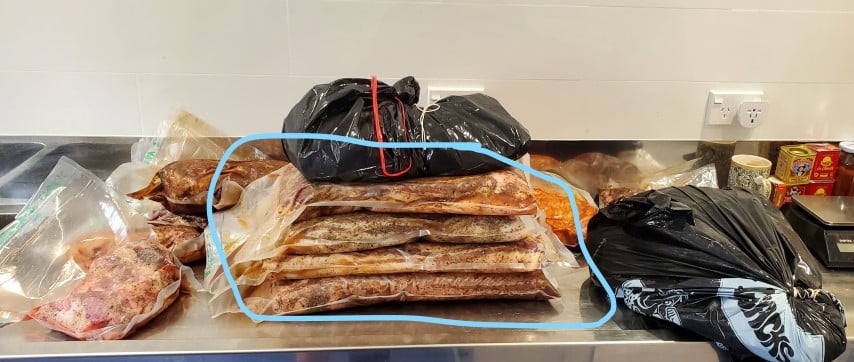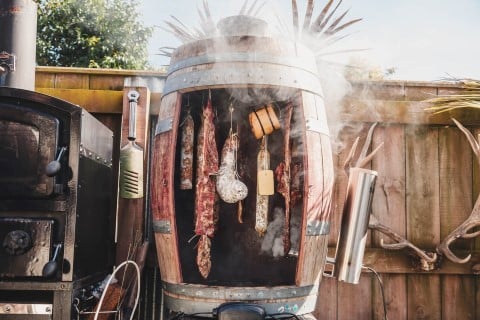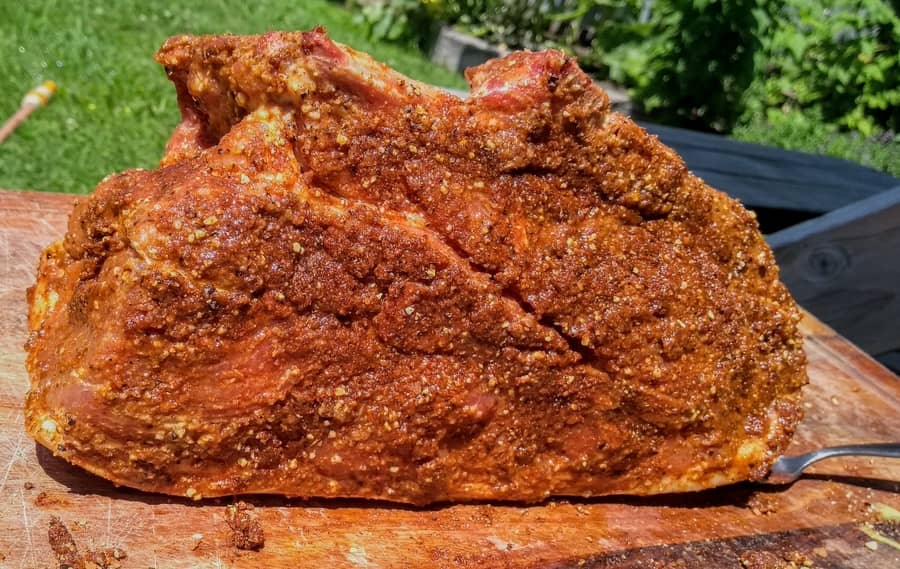Curing and Smoking is often seen as a similar or the same process and are often related or depending on the recipe. However, the question is – is smoking meat a type of curing? Let’s get into this in detail!
I have cured all different types of meat whether it’s red meat or different types of fish.
For some things I’m making I will add smoke – cold smoking is for flavor and drying the meat out, too.
Hot smoking which basically is cooking with hot smoke for flavor during the cooking process.
The thing is when you smoke meat are you always curing? Well, that depends on what you make.
Direct hot smoking at low temperatures otherwise known as low and slow smoking is so popular, that this is often the only way people see smoked foods.
For all the ‘low and slow smoking’ I’ve done – and also seen and eaten in restaurants and festivals to check it out. I found you only apply a seasoning rub on the outside of the meat, and then you render the fat during the cooking and smoking process.
To me, this does not involve any curing.
At the end of the day, smoking meat is not curing meat.
Curing meat is either to hold moisture on the surface of the meat during cooking, or to inhibit the meat completely to slow water activity, therefore making the environment inside the meat less appealing to unwanted bacteria that spoil the meat.
Can You Cure Meat with Just Smoke
No, because curing meat involves salt to either hold moisture during cooking or preserve the meat. Smoking meat is either done at hot or cold temperatures, it does not perform the ability that salt does. to meat when salt curing.

You can dry meat with cold smoke, for a preserving survival function. This does not involve any salt curing, it’s just using cold smoke (smoke well under 86°F/30°C), airflow, and thin cuts of meat.
The smoke carries antimicrobial properties, which means it keeps bugs and insects away, including the unwanted bugs/bacteria that you can’t see also.
If I could, I would always salt meat before cold smoking for preservation, this is a much safer process. This is why I mention it as a survival preservation technique specifically.

Is Smoking and Curing Meat the Same Thing?
No
Smoking is either for flavor or to assist the preserving such as cold smoking, if it’s only for cooked food and it is hot smoking.
If you want to get technical cold smoking is below 30°C/86°F, and hot smoking, as well as warm smoking (which is a whole other subject), is above this temperature. Low and slow smoking is done with indirect heat above 200°F/100°C.
Curing on the other hand, always involves sea salt.
If the goal of curing is to cure the surface of the meat to hold moisture during the cooking process, it is, for example, like brining a turkey for Thanksgiving in America.
If you do salt curing to penetrate the meat right to the core with sea salt, which is fully curing. This inhibits the meat and slows the water activity inside the meat cells, which therefore makes it environment unwanted bacteria don’t like.
Technically, from what I know, it is called binding and diffusion – these are the chemical processes.
Basically, this is preserving meat.
There is also some confusion about sodium nitrates and sodium nitrites being cures. Because they are called pink curing salts (with many other names like Prague Powder, InstaCure etc.). They are part of many curing processes, but they are not the definition of curing which is basically salt and meat to perform a certain outcome.
What is the Goal of Smoking the Meat?
To either smoke and cook the meat like hot smoking or low and slow smoking the goal is just for flavor.
Or the goal is to cold smoked meat which starts with the salt curing process for preservation traditionally, but more recently for flavor as the focus.
What Technique or Outcomes are you Trying to Achieve When Smoking?
- Cooking Meat with Smoke to Temperature that’s Safe to Eat
- Cold Smoking, salt-cured meat to flavor/preserve
Is Smoking a Form of Curing?
No, smoke is for flavor or preserving

How Do You Smoke and Cure Meat in the Wild?
In a survival context, you could cut the meat thin and have a stick-built rack system with enough distance away from the smoldering fire.
You could dry and cold smoke the meat at the same time, this would be a form of preserving the meat.
But you’d also need to be in an environment that is conducive to it – like in summer in temperate environments. if it rains then you would struggle to remove the moisture out of the meat to perform a preserving effect over a smoldering fire.
Luckily, I never had a meat survival scenario. Next time, I’ll try it and report back on it.
Do You Have to Cure Meat Before Smoking?
For Drying and Curing meat, yes you do. For Low and Slow Hot Smoking, no you don’t
Because for dry curing you want the cure through the meat.
For Low and Slow Hot Smoking, you are cooking meat with a lot of fat. The moisture in the meat is based on rendering the fatty meat at low cooking temperatures (with smoke around the meat for flavor).
Often this is why Bovine/Beef from America are fenced up, so they can’t move. They become obese and then suited to fat rendering cooking.
Where I live in New Zealand, beef is in paddocks grass-fed and does not get fat. In America bovine is grain-fed has restricted movement and come in commercially large numbers of bovine.
Now Artificial Intelligence: I sometimes ask it questions that I know the answer to, referring to the confusing topic of curing and smoking – it got it wrong and corrected itself. Here is what it said:
Tom – Can you Cure Meat with Just Smoke?
Yes, meat can be cured with just smoke, a method known as cold smoking (In a survival context). Cold smoking is a process used to preserve and flavor meat, fish, and other foods by exposing them to smoke without applying heat. The smoke helps to inhibit the growth of bacteria and adds a distinct smoky flavor to the meat.
For example, when curing bacon(I wrote about bacon cured and uncured also), the meat is usually first salted or brined to draw out moisture and inhibit bacterial growth. After the salting or brining process, the meat is then cold smoked to infuse it with smoky flavors. The combination of these processes helps to create a safe and flavorful cured meat product.
So, while cold smoking can be a part of the meat curing process, it is not sufficient on its own to fully cure meat and ensure its safety for consumption.
Tom – But is smoking curing?
Yes, smoking can be a part of the curing process for certain types of meat. Curing is a method used to preserve and flavor meat, and smoking is one of the techniques employed in the curing process.
However, it’s important to note that smoking alone may not be sufficient to fully cure meat and make it safe for consumption. Many cured meats undergo additional steps, such as salting, brining, or using curing agents like nitrates or nitrites, to ensure proper preservation and safety.
So while smoking is a part of the curing process and contributes to both preservation and flavor, it is often combined with other techniques and ingredients to achieve a fully cured product.
Tom So you are saying cold smoking is the curing?
Apologies for any confusion. Cold smoking itself is not a complete curing method. Cold smoking primarily imparts flavor to the meat and can help preserve it to some extent, but it does not fully cure the meat and make it safe for consumption.
Curing typically involves a combination of techniques, which may include salting, brining, or using curing agents like nitrates or nitrites. These methods are used to draw out moisture, inhibit bacterial growth, and provide additional preservation.
It’s important to follow proper curing procedures, including the use of appropriate curing agents and techniques, to effectively cure meat and make it safe to eat.
Hence, you can see why I wrote a whole article on this, it’s confusing – even for a computer with decades of internet information at its fingertips.

Tom Mueller
For decades, immersed in studying, working, learning, and teaching the craft of meat curing, sharing the passion and showcasing the world of charcuterie and smoked meat. Read More
